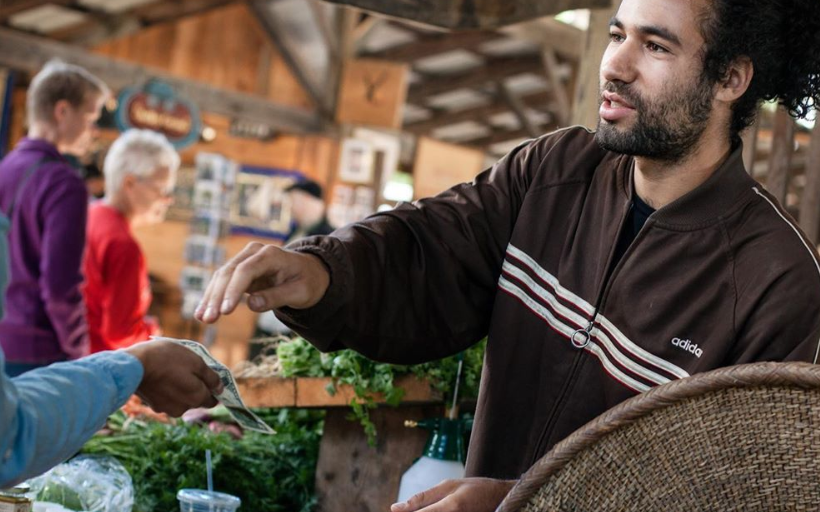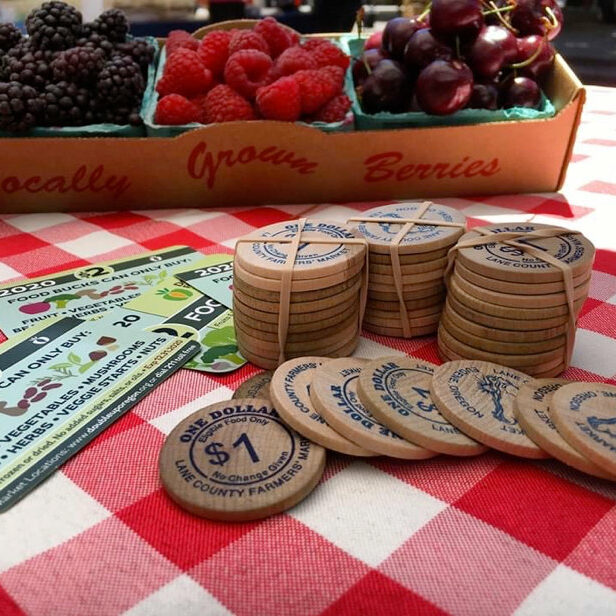Plan
Though all nutrition incentive projects are community-specific, there are common elements that make implementing and administering an incentive easier. In PLAN we give you tools to prepare ahead for a successful incentive project at your farm direct site.

In this section, you’ll find resources to help you prepare for an incentive that will effectively serve new customers, better support existing customers, and integrate your farmers market, CSA, or farm stand within a broader local context. With effective planning, nutrition incentives can help you draw together funders, partners, vendors, and customers into a thriving community.
Though all programs are community-specific, there are common elements that make implementing and administering incentives at your site easier. Let’s start by making sure your operation has one of the most basic capacities needed for a nutrition incentive: accepting SNAP as a form of payment.
Successful nutrition incentive projects tend to have experience and capacity to manage tracking, reporting, technology, and administrative challenges of accepting the SNAP program before they begin offering nutrition incentives. Some state and regional programs even require that markets have accepted SNAP for a certain time period before they become eligible for inclusion in the network.
Only about a quarter of farmers markets currently accept SNAP.
At the Farmers Market Coalition (FMC), we estimate that only about a quarter of farmers markets currently accept SNAP, so if your market is among the three-quarters that have yet to accept this currency, or you would like tools to help you improve your SNAP program, visit the FMC SNAP guide for help getting started, and getting better at SNAP.
One of the most important tools for both SNAP implementation and adding incentives at your market is a Community Needs Assessment (CNA). The key to planning your project is understanding the need for incentives in the community you serve. You may also wish to develop a community advisory board, where members of your community help make decisions about the future of your site. However you plan to receive input from your community, be sure to involve the people who are using SNAP and/or incentives at your site in the beginning stages of project planning and decision making. A CNA is one way to get a sense of the demand for this programming before you start to build.
The key to planning your project is understanding the need for incentives in the community you serve.
Once your SNAP program is up and running, you’ll need to consider whether your farm direct operation wants to join an existing nutrition incentive network operating in your state or region, or start your own project.
Existing programs offer resources and experience, including in some cases, funding for nutrition incentives. However, not all states or regions have an existing incentive, and you may even feel that a different project design would better serve your community. To help you find the state and regional projects that exist in your area, FMC has created a list of all state and regional projects in the United States that you can find in the resource lists below.

If you prefer to choose an existing incentive, your network will work with you to create materials for implementation and promotion of your farm direct operation, including scrip or tokens if you’re using them, signage, reporting expectations, and a plan for community outreach. Regardless of whether you join a network or do it yourself however, remember that as the farm direct operator, you have the partnerships and expertise necessary to make your program work for your local community. No nutrition incentive project can be successful without buy-in from the customers and staff and vendors who will be using it day to day. Be sure that materials and designs received from your state or regional partner reflect your specific needs. See our IMPLEMENTATION and PROMOTION sections for ideas on how this can be done, and remember that successful sites test and try out new ideas all the time: in the long term, you’ll get the chance to revise and REITERATE your project.
If you’d like to start your own program, you’ll need help. Luckily, a number of successful farm direct operators have created guides to starting nutrition incentive projects from the ground up. In the Resource Library section of this guide site, we’ve gathered numerous guides to “getting started,” some of which are listed below. You may also want to base your incentives on other programs or criteria in addition to SNAP, whether that’s the Women, Infants & Children (WIC) or Senior Farmers Market Nutrition Program (FMNP), or a Power of Produce (P.O.P.) club, which incentivizes younger market-goers to try new fruits and vegetables at market. For resources to help you consider additional incentives, see our list in the REITERATE section.
If you’d like to base your program on a national incentive model, you may be looking for a middle road between starting your own incentive from scratch and working with an existing local program in your state. Programs like Double Up Food Bucks and Wholesome Wave are national networks that offer support to local organizations to create nutrition incentive projects in accordance with the models they’ve developed and tested. See our resource list below for getting started guides from both of these national national networks.
Regardless of whether you start your own program, or join an existing regional or national one, remember that ANY incentive program based in SNAP purchases has to get a waiver from the USDA Food and Nutrition Service unless it is federally funded. GusNIP-funded programs and other federally funded SNAP-based nutrition incentives don’t require a waiver, but if your SNAP authorized retail operation wants to create a SNAP-based incentive using only philanthropic, community, or state-level funding, you’ll need a waiver from FNS. This is to ensure that the rule requiring customers who use SNAP to be treated the same as any other customer is being respected.
The PLAN section offers a wealth of resources to get you started, but remember that market operators can’t develop an accurate perception of what it’s like to use SNAP at their market on their own. Paying shoppers who use SNAP for their expertise and speaking with community partners who work closely with clients who receive SNAP benefits may be valuable ways to understand the barriers and needs present in your community. Here are some questions to consider as you look for a better understanding of the needs of shoppers who use SNAP:
- How many people use SNAP in your community?
- How many people would use SNAP incentives at your site if they knew they could do so?
- Have people come to your site looking to use SNAP or asked if you accept SNAP already? How often does this occur?
- Are there people who use SNAP at your site who would be willing to advise you in program creation?
- What potential obstacles–such as transportation, language barriers, perceptions of stigma, or hours of operation–might stand in the way of program success? Are there partners who might be able to help you overcome these obstacles?
- Once your PLAN is in place, you’ll need to develop internal and at-market systems to make your program a success. For guidance on how to do this, check out our IMPLEMENT section.
Resource Library Guide: PLAN
See our best-in-class resources to help you plan your farm direct nutrition incentive below.
SNAP Guides
Guides to accepting SNAP at farm direct sites.
SNAP Guide for Farmers Markets
How SNAP Works for CSAs
Nutrition Incentive Guides
These guides explore the basics of SNAP-Based Nutrition Incentives.
Double Up Food Bucks National Network and Resources
Fresh Exchange: A Toolkit Guide to Launching and Sustaining a SNAP Benefits Matching Program at Your Farmers Market
How to Run a Nutrition Incentive Program: A Toolkit for Wholesome Wave's National Nutrition Incentive Network
EBT Incentive Program Toolkit: A How-To for New or Existing EBT Incentive Programs for the Farmers Markets of Washington State
Guide to Accepting Federal Nutrition Benefits at Farmers Markets in Maryland
CSA Incentives Toolkit
National Network Guides
These guides explore the basics of SNAP-Based Nutrition Incentives.
Double Up Food Bucks National Network and Resources
Fresh Exchange: A Toolkit Guide to Launching and Sustaining a SNAP Benefits Matching Program at Your Farmers Market
Community Needs and Community Advisory Boards
Resources for facilitating a Community Needs Assessment or a Community Advisory Board.
Community Needs Assessment Resource Guide
Conduct a Needs Assessment
2020 Mobile Market Conference
What is an Advisory Board and Should We Have One?
Centering Food on People, Not Process
Planning to Thrive
These resources support managers to integrate their incentives programming within a broader mission of access and inclusivity in farm direct.
Foster a Culture of Inclusivity at Your Market
Antiracist Farmers Markets – Making Progress Toward
Farmers Market Legal Toolkit
Developing a Purpose Driven Market Mission Statement
Incentives in Context
These resources offer the big picture of nutrition incentives work in farm direct, including a history of the US food system and farmers markets as the innovators of incentives programming.
Origins of Incentives: Incentivizing Behavior Change Through the Farmers Market Model
JEDI Talks Session One: Food Justice, Equity, Diversity, and Inclusion in Nutrition Incentives
Stage-by-stage Guides
Our stage-by-stage guides curate our library’s best resources to meet you at every stage of the nutrition incentive journey.
Plan
Learn the basics of nutrition incentives and start building a program at your farm direct site.
Learn moreImplement
Take your nutrition incentive program from seed to scale and find support for day-to-day administration.
Learn morePromote
Grassroots outreach, social media strategy, and more: learn how to connect with the community and build your customer base.
Learn moreEvaluate
How do you measure your program's results? Access our tools for data collection, management, and publication.
Learn moreReiterate
Turn your data into funding for new programming through reporting and storytelling.
Learn more